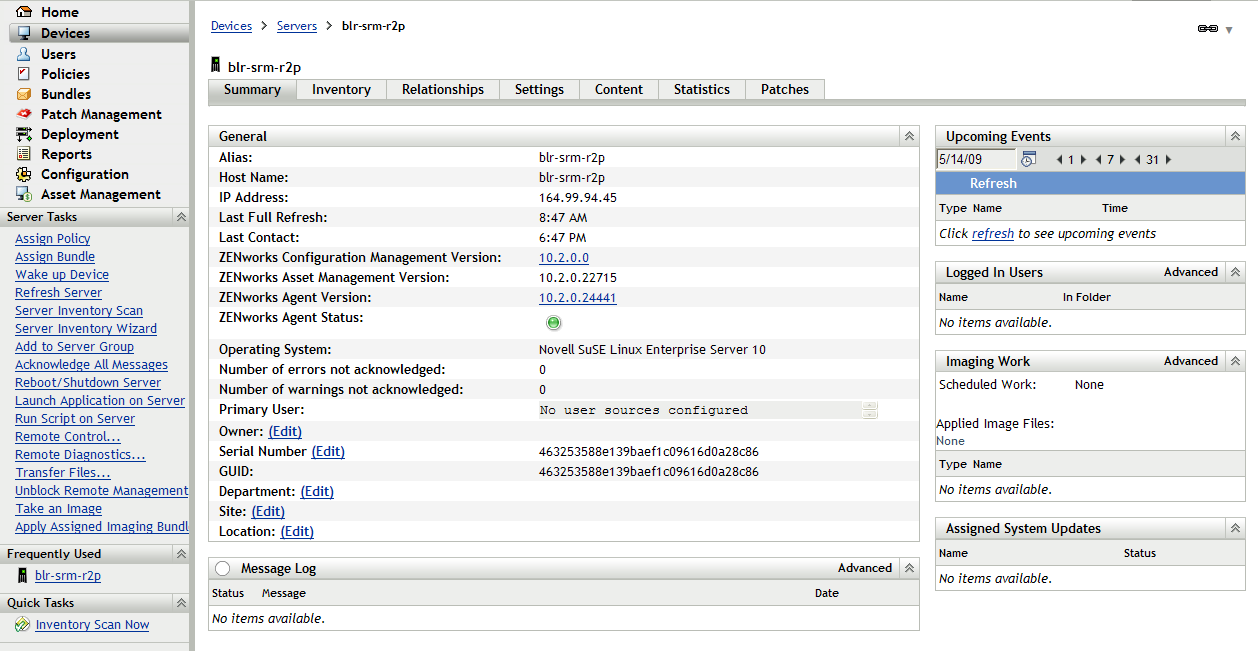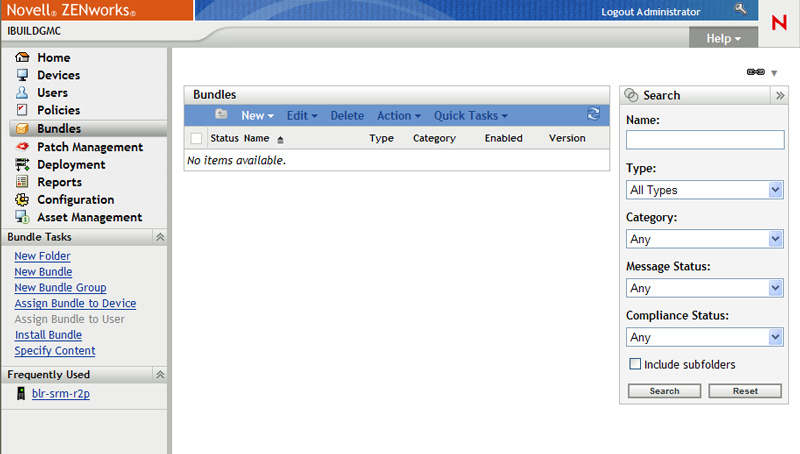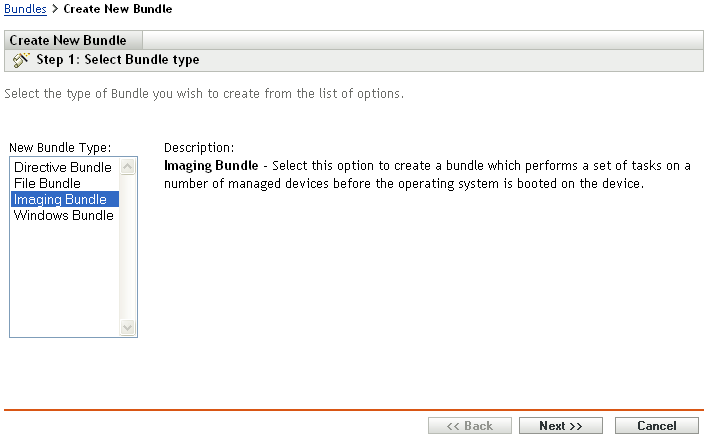4.3 Imaging Devices
You can create images of devices, apply images to devices, and run imaging scripts on devices. ZENworks Configuration Management uses its Preboot Services functionality to perform these imaging tasks on devices at startup.
4.3.1 Setting Up Preboot Services
To use Preboot Services, you need to complete the tasks in the following sections:
Enabling PXE on a Device
Preboot Services requires PXE (Preboot Execution Environment) to be enabled on any managed device where you want to take or apply an image.
To check if PXE is enabled on a device, restart the device and select the boot option (F12 on most devices). PXE is enabled if there is a network boot option.
If PXE is not enabled on a device, edit the device BIOS to enable it. In order to ensure that the PXE environment is available each time the device starts, you can also change the boot order so that the NIC (Network Interface Card) option is listed before the other boot options.
Setting Up an Imaging Server
The Imaging Server is the PXE server that a device’s PXE engine connects to. To enable a ZENworks Server to function as an Imaging Server, you simply need to start the Novell Proxy DHCP Service on the ZENworks Server. When you start the service, you should also change the startup type from Manual to Automatic so that it starts whenever the server reboots.
Configuring the Third-Party Imaging Settings
If you want to use the third-party imaging solutions, you must configure the Third-Party Imaging Settings in ZENworks Control Center. ZENworks supports the following third-party imaging tools:
-
Microsoft ImageX that uses the WIM image file format and WINPE as the distro
-
Symantec Ghost that uses the Ghost image file format and WINPE as distro
The ZENworks third-party Imaging supports only PXE as the boot mechanism.
To configure the Third-Party Imaging settings:
-
Ensure that Microsoft Windows Automated Installation Kit 1.0/1.1 (WAIK) is installed on the device running the ZENworks Control Center.
You can freely downloaded WAIK from the Microsoft Download Center Web site.
-
(Conditional) If you want to run ZENworks Control Center on a 64-bit device, append the WAIK_installation_path\Windows AIK\Tools\x86 to the Path Windows system environment variable.
-
Configure the third-party Imaging settings in ZENworks Control Center.
-
In ZENworks Control Center, click tab.
-
In the panel, click > > the panel.
-
In the option, click
 to upload the WIM Imaging file. In the Upload WIM Imaging Files dialog box, do the following
to upload the WIM Imaging file. In the Upload WIM Imaging Files dialog box, do the following
-
Click to browse for and select winpe.wim.
By default, winpe.wim is installed in \waik\tools\petools\x86.
NOTE:If you have not installed the Novell File Upload extension on this device, you must do so before you can browse to and upload directories to be installed.
-
Click.
This downloads the Imaging files from server to the device running ZENworks Control Center and also uploads files from the device to the server. The progress of download and upload of files is displayed in the field.
-
-
In the option, click
 to browse for and select the Microsoft Imaging engine (imagex.exe) installed on the device running ZENworks Control Center. By default, imagex.exe is installed in \waik\tools\x86.
to browse for and select the Microsoft Imaging engine (imagex.exe) installed on the device running ZENworks Control Center. By default, imagex.exe is installed in \waik\tools\x86.
-
In theoption, click
 to browse for and select the Symantec Ghost engine (ghost32.exe) installed along with the Ghost solution on any device in your network.
to browse for and select the Symantec Ghost engine (ghost32.exe) installed along with the Ghost solution on any device in your network.
-
After configuring the third-party Imaging settings, click .
-
Click to view the status of content replication across all Primary Servers in the Management Zone. You must start the Imaging operation only when the status is .
IMPORTANT:You must start the Imaging operation only when the status is .
-
-
Enable PXE on the device.
-
Ensure that you have a standard DHCP server, either on your Imaging Server or on another network server.
4.3.2 Taking an Image
-
In ZENworks Control Center, click the tab.
-
Navigate the Servers or Workstations folder until you locate the device whose image you want to take.
-
Click the device to display its details.

-
In the task list located in the left navigation pane, click to launch the Take an Image Wizard.
-
On the File Information page, fill in the following fields, then click .
Image Format: Select the format of the image to be taken for the device
Server and File Path: Click the
 icon to display the Server and Path Information dialog box. Configure the following options.
icon to display the Server and Path Information dialog box. Configure the following options.
-
Server Object/IP/DNS: Click the
 icon to browse for and select the object, IP address, or DNS name of the Primary Server or the device that is promoted to the Imaging Server role.
icon to browse for and select the object, IP address, or DNS name of the Primary Server or the device that is promoted to the Imaging Server role.
-
File Path on Server: Click the
 icon to browse for and select an image file. The image file must have the .zmg filename extension, meaning it is a valid ZENworks image file.
icon to browse for and select an image file. The image file must have the .zmg filename extension, meaning it is a valid ZENworks image file.
NOTE:You cannot browse to the specified file system if multiple search domains with DHCP are configured for Linux and if the server is on Windows.
Shared Network Path for Image File: Specify the shared-network path where you want to save the .wim or .gho files. The directory must be a Windows share or a Linux SMB or CIFS share.
If you have not installed the Novell File Upload extension on this device, you must do so before you can browse to and upload directories to be installed.
Image Filename: Specify the filename to save the .wim or the .gho file. This option is displayed only for the Windows Imaging Format (.wim) and Ghost Imaging Format (.gho).
Network Credential: Click
 to browse for and select the network credentials to be used for accessing the device having .wim files. This option is displayed only for the Windows Image Format (.wim) and Ghost Image Format (.gho).
to browse for and select the network credentials to be used for accessing the device having .wim files. This option is displayed only for the Windows Image Format (.wim) and Ghost Image Format (.gho).
Use Compression: Compression is required. Choose one of the following:
-
Balanced: Automatically balances compression between an average of the reimaging speed and the available disk space for the image file. This option is displayed only for the ZENworks Image format
-
None: This option is displayed only for the Windows Image format and Ghost Image format.
-
Optimize for Speed: Optimizes the compression to allow for the fastest reimaging time. Use this option if CPU speed is an issue.
-
Optimize for Space: Optimizes the compression to minimize the image file’s size to conserve disk space. This can cause reimaging to take longer.
is the default option for the ZENworks Image format and is the default option for the Windows Image format and Ghost Image format.
Create an Image Bundle: Leave this field deselected.
-
-
Review the information on the Image File Summary page, click , then click .
Because imaging tasks are completed by Preboot Services, the image of the device is taken the next time the device reboots. The Imaging Work panel, located on the device’s Summary page, shows that the work is scheduled. When the work is completed, the task is removed from this panel.
-
To reboot the device immediately and initiate the imaging work, click (or ) in the left navigation panel.
The time required to take the image depends on the size of the device’s drives.
4.3.3 Applying an Image
To apply an image to a device, you use the Create New Bundle Wizard to create an Imaging bundle. The bundle contains the image you want to apply. In addition to helping you create the bundle, the wizard also lets you assign it to devices. After creating the Imaging bundle, you then initiate the imaging work.
Creating the ZENworks Image Bundle
To restore ZENworks images on a device, you must create the ZENworks Image bundle.
-
In ZENworks Control Center, click the tab.

-
In the Bundles panel, click > to launch the Create New Bundle Wizard.

-
On the Select Bundle Type page, select , then click .
-
On the Select Bundle Category page, select , then click .
-
Complete the wizard using information from the following table to fill in the fields.
Creating the Third-Party Image Bundle
To restore the third-party images, you must create the Third-Party Image bundle.
-
In ZENworks Control Center, click the tab.

-
In the Bundles panel, click > to launch the Create New Bundle Wizard.

-
On the Select Bundle Type page, select , then click .
-
On the Select Bundle Category page, select , then click .
-
Complete the wizard using information from the following table to fill in the fields.
Initiating the Imaging Work
-
In ZENworks Control Center, click the tab.
-
Navigate the Servers or Workstations folder until you locate the device where you want to apply the image.
-
Click the device to display its details.
-
In the task list located in the left navigation pane, click to schedule the work.
Because imaging tasks are completed by Preboot Services, the image is applied to the device the next time the device reboots. The Imaging Work panel, located on the device’s Summary page, shows that the work is scheduled. When the work is completed, the task is removed from this panel.
-
To reboot the device immediately and initiate the imaging work, click (or ) in the left navigation panel.
4.3.4 Where to Find More Information
For more information about imaging and Preboot Services, see the ZENworks 10 Configuration Management Preboot Services and Imaging Reference.